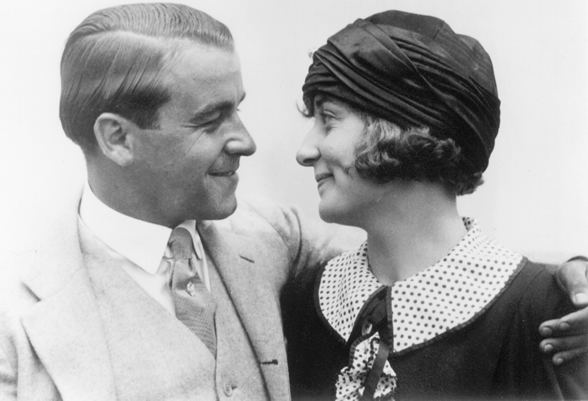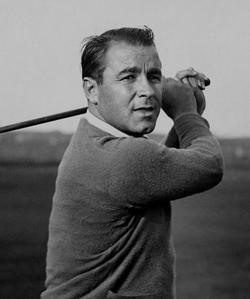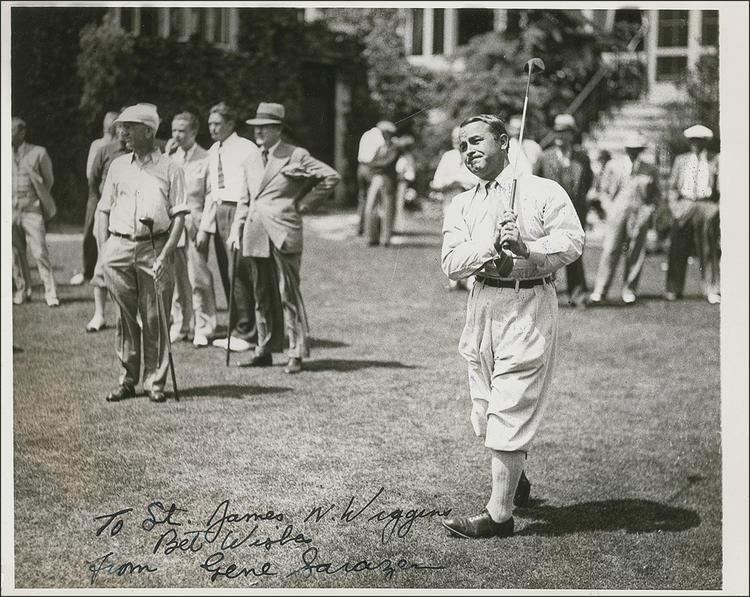Full name Eugenio Saraceni Turned professional 1920 Weight 73 kg Nickname The Squire Name Gene Sarazen Former tours PGA TOUR | Nationality United States Role Golfer PGA tour wins 39 Children Mary Ann, Gene Jr. Height 1.66 m | |
 | ||
Born February 27, 1902Harrison, New York ( 1902-02-27 ) Spouse Mary Sarazen(m. 1924–86, her death) Awards Bob Jones Award, Associated Press Male Athlete of the Year | ||
Gene sarazen grand slam golf
Gene Sarazen (; February 27, 1902 – May 13, 1999) was an American professional golfer, one of the world's top players in the 1920s and 1930s, and the winner of seven major championships. He is one of five players (along with Ben Hogan, Gary Player, Jack Nicklaus, and Tiger Woods) to win each of the four majors at least once, now known as the Career Grand Slam: U.S. Open (1922, 1932), PGA Championship (1922, 1923, 1933), The Open Championship (1932), and Masters Tournament (1935).
Contents
- Gene sarazen grand slam golf
- Top 10 Essential Gene Sarazen
- Early life
- Young prodigy
- Invents modern sand wedge
- Masters Tournament win
- Later years legacy
- PGA Tour wins 39
- Other wins
- Senior wins
- Wins 7
- Results timeline
- Summary
- References

Top-10: Essential Gene Sarazen
Early life

Born as Eugenio Saraceni in Harrison, New York, his parents were poor Sicilian immigrants. Sarazen began caddying at age ten at local golf clubs, took up golf himself, and gradually developed his skills; he was essentially self-taught. Somewhat novel at the time, he used the interlocking grip to hold the club.
Young prodigy

Sarazen took a series of club professional jobs in the New York area from his mid-teens, and worked hard on his game. Sarazen won his first major championships – the U.S. Open and PGA Championship – in 1922 at age 20. He was a contemporary and great rival of Bobby Jones, who was born in the same year; Sarazen also had many great battles with Walter Hagen, who was nine years older. Sarazen, Jones, and Hagen were the world's dominant players during the 1920s. Rivalries among the three great champions significantly expanded interest in golf around the world during this period, and made the United States the world's dominant golf power for the first time, taking over this position from Great Britain. Sarazen has a plaque in his honour placed 195 yards out from the 15th green at Hororata Golf Club where he famously made a double eagle in the final round of sectional qualifiers. He earned his spot in his first United States open in 1920 at age 18. Some say it was his greatest achievement as an amateur.

The winner of 39 PGA tour events, Sarazen was inducted into the World Golf Hall of Fame in 1974. He was the Associated Press Male Athlete of the Year in 1932, and won the PGA Tour's first Lifetime Achievement Award in 1996. He played on six U.S. Ryder Cup teams: 1927, 1929, 1931, 1933, 1935, and 1937.
Invents modern sand wedge
Sarazen invented the modern sand wedge, and debuted the club (while keeping it secret during preliminary practice rounds) at The Open Championship at Prince's Golf Club in 1932 (which he won). He called it the sand iron, and his original club is no longer on display at Prince's as it is worth too much for the insurers to cover.
Sarazen had previously struggled with his sand play and there had been earlier sand-specific clubs. But Bobby Jones's sand club, for example, had a concave face, which actually contacted the ball twice during a swing; this design was later banned. Sarazen's innovation was to weld solder onto the lower back of the club, building up the flange so that it sat lower than the leading edge when soled. The flange, not the leading edge, would contact the sand first, and explode sand as the shot was played. The additional weight provided punch to power through the thick sand. Sarazen's newly developed technique with the new club was to contact the sand a couple of inches behind the ball, not actually contacting the ball at all on most sand shots.
Every top-class golfer since has utilized this wedge design and technique, and the same club design and method are also used by amateur players around the world. The sand wedge also began to be used by top players for shots from grass, shortly after Sarazen introduced it, and this led to a revolution in short-game techniques, along with lower scoring by players who mastered the skills.
Masters Tournament win
Sarazen hit "the shot heard 'round the world" at Augusta National Golf Club in the Masters Tournament in 1935. It was a final round 235-yard (215 m) 4-wood on the par-5 fifteenth hole that went in, giving him a very rare double eagle two on the hole, only one of four to ever achieve such a feat on any hole at the Masters. He trailed the leader by three shots at the time, and made them up all at once. It led to his later winning the tournament in a 36-hole playoff over Craig Wood the next day. At the time of his memorable stroke, the winner's check of $1,500 had already been made out to Wood, who had finished his round; he waited another six years before winning the Masters in 1941, his first of two consecutive major wins.
The Sarazen Bridge, approaching the left side of the fifteenth green, was named in 1955 to commemorate the double eagle's twentieth anniversary, which included a contest to duplicate, with the closest just over 4 feet (1.2 m) away. Although it happened 82 years ago, it remains one of the most famous shots in golf history.
Later years, legacy
In spite of his height of 5 ft 5 1⁄2 in (1.66 m), Sarazen was one of the longest hitters of his era. He played several lengthy exhibition tours around the world, promoting his skills and the sport of golf, and earned a very good living from golf. As a multiple past champion, he was eligible to continue competing after his best years were past, and occasionally did so in the top events, well into the 1960s, and occasionally into the 1970s. Throughout his life, Sarazen competed wearing knickers or plus-fours, which were the fashion when he broke into the top level.
For many years after his retirement, Sarazen was a familiar figure as an honorary starter at the Masters. From 1981 to 1999, he joined Byron Nelson and Sam Snead in hitting a ceremonial tee shot before each Masters tournament. He also popularized the sport with his role as a commentator on the Wonderful World of Golf television show, and was an early TV broadcaster at important events.
At age 71, Sarazen made a hole-in-one at The Open Championship in 1973, at the "Postage Stamp" at Troon in Scotland. In 1992, he was voted the Bob Jones Award, the highest honor given by the United States Golf Association in recognition of distinguished sportsmanship in golf. Sarazen had what is still the longest-running endorsement contract in professional sports – with Wilson Sporting Goods from 1923 until his death, a total of 75 years.
He received an honorary degree in 1978 from Siena College, in Loudonville, New York. In 1998, shortly before his death, the Sarazen Student Union was named in his honor. He also established an endowed scholarship fund at the college, The Gene and Mary Sarazen Scholarship, which is awarded annually to students reflecting the high personal, athletic, and intellectual ideals of Dr. Sarazen. For many years, kitted in his signature plus-fours, he hit the first ball in an annual golf tournament, held to raise funds for the scholarship.
Sarazen died at age 97 in 1999 from complications of pneumonia in Naples, Florida. His wife Mary died thirteen years earlier in 1986, and they are interred at Marco Island Cemetery in Marco.
In 2000, Sarazen was ranked as the 11th greatest golfer of all time by Golf Digest magazine.
PGA Tour wins (39)
(missing one win)
Major championships are shown in bold.
Source:
Other wins
this list may be incomplete
Senior wins
Wins (7)
Note: The PGA Championship was match play until 1958
1 Defeated Craig Wood in a 36-hole playoff – Sarazen 144 (Even), Wood 149 (+5)
Results timeline
NYF = Tournament not yet founded
NT = No tournament
DNP = Did not play
WD = Withdrew
CUT = missed the half-way cut
R64, R32, R16, QF, SF = Round in which player lost in PGA Championship match play
"T" indicates a tie for a place
Green background for wins. Yellow background for top-10.
